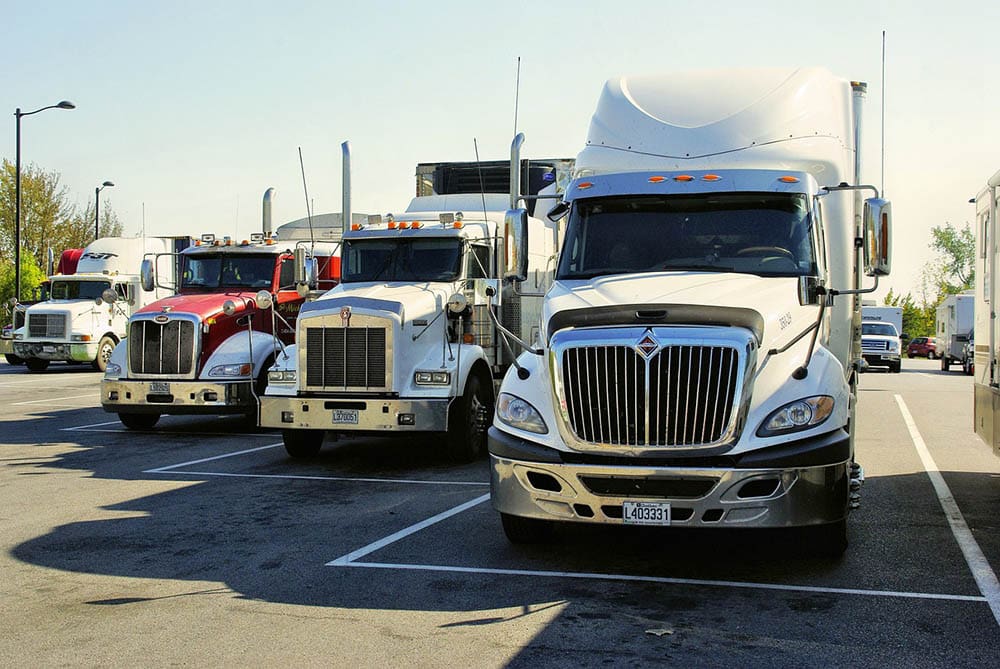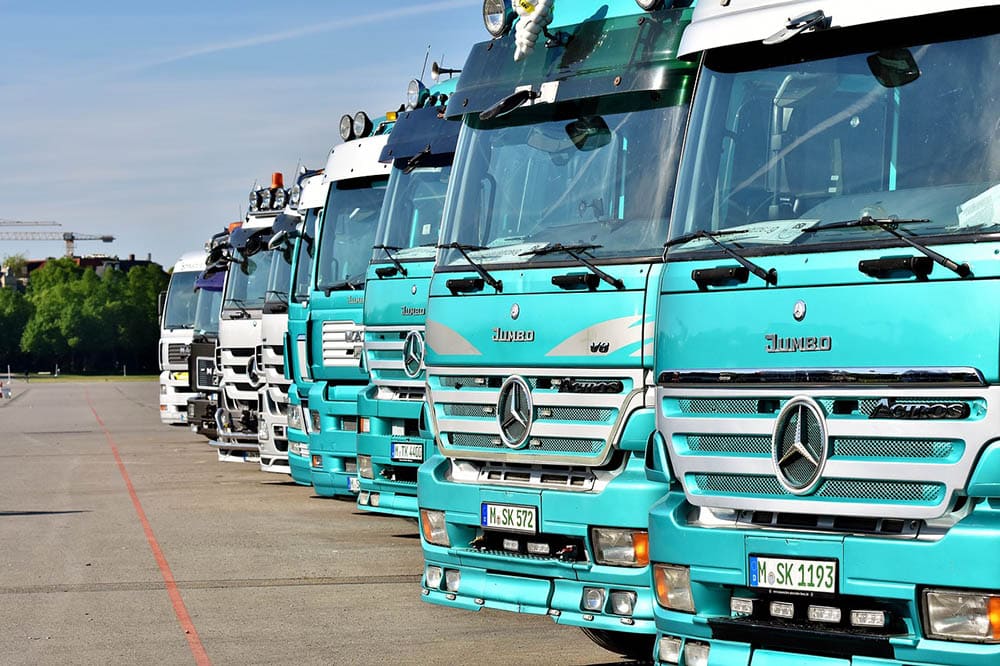12 Trucking & Transportation Industry Statistics in Australia: 2025 Update
-
Pete Ortiz
- Last updated:

Note: This article’s statistics come from third-party sources and do not represent the opinions of this website.
The transportation industry is growing in importance in Australia thanks to improving infrastructure and increased demand. The logistics market¹ already exceeds $81 billion, and the anticipated growth should push it to over $114 billion by 2027.
Much is changing in Australia’s transport markets, and more needs to change. It isn’t all smooth sailing for the industry or its workers, and changing global and domestic struggles emphasize the need to evolve. Let’s review some of the highs, lows, and implications for the future with these 12 trucking and transportation industry statistics in Australia.
Click below to jump ahead:
- Transportation Industry Overview
- Trucking Industry Statistics
- Transportation Worker Profile
- Trucking and Transport Impact
The 12 Trucking and Transportation Industry Statistics in Australia
- Australia transported over 800 billion ton-kilometers of goods in 2020.
- Nearly 93% of railroad-transported goods are bulk freight, and 61% of road freight consists of non-bulk goods.
- Road freight transport generates $65.3 billion in revenue.
- There are 47,162 road freight transport companies in Australia.
- Australia is home to roughly 200,000 truck drivers.
- The transport and logistics industry is expected to exceed 600,000 employees by 2026.
- The average transportation worker is 45 years old.
- Truck drivers are more likely to be obese than average Australians.
- Women make up only 16% of the trucking workforce.
- Freight vehicles make up over 20% of vehicles on Australian roads.
- Freight-carrying vehicles burned 12,479 megaliters of diesel in 2020.
- Over one-third of emissions from the transport industry come from road freight.

Transportation Industry Overview
1. Australia transported over 800 billion ton-kilometers of goods in 2020.
(Bureau of Infrastructure and Transport Research Economics)
The Australian domestic freight task is expanding, as it has for the last 40+ years. Between rail, road, and coastal shipments, the transport sector moved 800.4 billion ton-kilometers of goods in 2020, a 2.4% increase from the prior year. The only area that took a step back was air freight, though its 0.3% contribution does little to affect the general numbers.
Railroads, roads, and even coastal paths saw similar use for transporting goods until the late 1990s when rail and, to a lesser extent, road transport took off. Rail accounts for 453.1 billion tkm of transported goods, followed by road transport with 235.4 billion tkm.

2. Nearly 93% of railroad-transported goods are bulk freight, and 61% of road freight consists of non-bulk goods.
(National Freight and Supply Chain Strategy)
The greatest driver of the railroad industry’s explosion is Australia’s export market. Bulk freight makes up 92.8% of the transported goods on rail lines. Over half of the freight is iron ore, the country’s principal export, while coal constitutes over a third.
Unsurprisingly, West Australia manages most of the rail transportation, running 170.9 billion tkm of freight in 2020, nearly three times that of the next-busiest state, Queensland (60.07 billion tkm).
With the proximity to major ports, mined resources cover a much smaller transported distance than many other goods in Australia. The extracted iron ore from the Pilbara region in Western Australia comes primarily from inland towns around Port Hedland, the country’s largest port and the world’s largest bulk export port by tonnage.
Road transport rules non-bulk freight, the kind of goods needed in commercial areas on the eastern side of Australia. There were 141.5 billion tkm of goods moved via road transport, accounting for 61% of goods moved in trucks. While rail has the highest overall numbers, road transport moves over four times more non-bulk freight than rail lines.
3. Trucking transport generates $65.3 billion in revenue.
(IBIS World)
Road freight services may have “only” moved about 235.4 billion tkm worth of goods in 2020, but they showed the largest leap of any transportation sector, a 5.6% increase from 2019. And despite moving less than rail, its value of $65.3 billion is the highest of any transportation sector.
Increases in road freight have been solid since the 1970s. While rail’s meteoric rise has slowed to a snail’s pace in recent years, road freight shows steady improvements.
Even as the transport industry’s gross value added (GVA) dropped nearly $7 billion from the year before, road freight ended the 2020–2021 FY with an increase of over $2 billion. Its $28.8 billion GVA accounted for more than 37% of the entire transport industry’s total contribution.

Trucking Industry Statistics
4. There are 47,162 road freight transport companies in Australia.
(IBIS World)
Following a dip in numbers in 2013, road freight transport businesses are quickly becoming more abundant in Australia. There are 47,162 companies in operation currently, a 1.5% increase from the previous year. It’s a slight decline from the 2.4% annual growth the industry has seen from 2017 to 2022. But overall, the addition of over 7,500 new businesses since 2013 is an impressive mark.
5. Australia is home to roughly 200,000 truck drivers.
(Labour Market Insights)
There are 199,900 truck drivers in Australia, accounting for roughly one-third of the 574,080 workers in the transport and logistics industry. Roughly 69% of those drivers perform general heavy truck driving for transporting bulky goods, while the next largest segment consists of furniture transporters.

6. The road freight transport industry is expected to exceed 600,000 employees by 2026.
(Australian Industry Standards)
As business expands and the demand for trucking in Australia increases, the industry anticipates a workforce of 600,648 employees in 2026, a 4.6% increase from 2021. Unfortunately, interest is waning, and the country faces a mounting driver shortage.
Training enrollments dropped by nearly one-third from 2016 to 2020, while completions decreased by over 50%. With the average age of truck drivers pushing 50, it’s challenging to make up for older individuals leaving the workforce.
Australian governments are implementing new training and safety programs to bring in new workers, but many young people don’t favor the prospect of long hours and potentially poor work environments.
Transportation Worker Profile
7. The average transportation worker is 45 years old.
(Australian Industry and Skills Committee)
Transportation and logistics workers are an older crowd. The industry’s average employee age is 45.6 years, well above the Australian worker’s average age of 40 years old.
Truck drivers are even older. The average driver age across the transport industry is 47 years old, with the typical freight truck driver’s age being 48 years. The youngest truck drivers are furniture movers at 34 years old. On the other side of the spectrum are tanker drivers, who pull the total industry age up with their average age of 50 years!

8. Over 50% of Australian truck drivers are obese.
(Monash University)
Truck drivers aren’t just older than the average Australian; they’re more likely to be out of shape too. A 2020 trucker survey found that 54.3% were obese, a far cry from the nation’s 32.5% average, with most of the overweight drivers being long-haul truckers. More than a third of truck drivers had back problems, and 25.8% reported having high blood pressure.
The nature of trucking doesn’t inspire healthy eating or exercising. Australian truckers spend up to 12 hours on the road, limiting their physical activity, and have limited access to healthy food options at truck stops.
9. Women make up only 17.6% of the road transport workforce.
(BITRE)
It may not be surprising that only 3% of truck drivers are female, but women are generally underrepresented across the entire road freight industry. In 2020, women only made up 17.6% of the workforce, the lowest percentage of any transport industry type.
Air and space transport has the highest percentage of females at 32.3%, but the railroad industry shows the healthiest upswing in inclusion. Women only accounted for 10.7% of the rail transport industry in 2000 and now makeup nearly one-quarter of the workforce.

Trucking and Transport Impact
10. Freight vehicles make up 20% of vehicles on Australian roads.
(Australian Bureau of Statistics)
Freight vehicles take up approximately one-fifth of the road in Australia. Roughly 3.4 million light commercial vehicles accounted for 84.5% of transport vehicles in 2020, while only 2.6% were articulated trucks. But speaking to their efficiency, articulate trucks still carry over 77% of all road freight!
11. Freight-carrying vehicles burned 12,479 megaliters of diesel in 2020.
(ABS)
The vast majority of rigid and articulated trucks still rely on diesel. Approximately 99.8% of these heavy-duty vehicles used nearly 7,500 megaliters of diesel fuel in 2020. Overall, freight-carrying vehicles burned through 12,479 megaliters.
Articulated vehicles only take up a small fraction of the vehicles on the road, but their diesel consumption has helped push the relative usage to equal gasoline usage in Australia. The typical articulated vehicle consumes 53.1 liters per 100 kilometers and travels 78,300 kilometers. By contrast, light commercial vehicles only use 12.8 liters of gas per 100 kilometers while averaging 15,300 kilometers.

12. Over one-third of emissions from the transport industry come from road freight.
(Electric Vehicle Council)
While the number of vehicles on the road is low, the environmental impact of articulated transport trucks is difficult to understate. Articulated trucks release 12.83% of the CO2 from all road vehicles despite accounting for only 0.5% of the total vehicles in Australia.
Heavy vehicles consume nearly a quarter of the fuel in all vehicles on the road. Given their higher emissions, they contribute 38% of the total emissions in the transport sector. Aging and relatively inefficient trucks and a push for advanced infrastructure are leading many to advocate for the adoption of electric fleets.
Frequently Asked Questions
What Are Road Trains?
Australia’s lengthy desolate expanse from its industrious western side to its commercial hubs in the east requires and allows for some unique transport options. Unlike the single semis in America, Australia’s largest trucks consist of a prime mover pulling up to three semi-trailers.
A road train can extend up to 53.5 meters long, though private mining company road trains often don’t have to adhere to government-set limits. The world record for longest road train was 1,474.3 meters long and had 113 trailers behind the prime mover. It set a record by driving 150 meters at a special exhibition.
(Guinness World Records)
Where Does Most Trucking Activity Take Place?
Most of Australia’s trucking movement takes place in the eastern states of New South Wales, Victoria, and Queensland. Nearly 34% of the 230 billion tkm that moves through the country occurs in New South Wales. Victoria and Queensland both feature just under 20% of the country’s total transported goods.
(BITRE)

What Is a Typical Truck Driver Income in Australia?
The median weekly wage for truck drivers in Australia is $1,663, surpassing the national median of $1,593. The higher pay doesn’t necessarily mean a better per-hour rate. Truck drivers also log more hours, with 85% putting in full-time hours, compared to the 66% average for all jobs.
(Labour Market Insights)
Conclusion
The trucking and transportation industry in Australia is growing, even if those involved aren’t ready for it. The economy will spur a push for more transport to keep up with demand. Government and industry leaders are doing their part to ease the burden and prepare for the future. But with an ongoing labor shortage and a growing onus to explore alternative energy sources, there are plenty of people left to please.
See Also:
Featured Image Credit: ArtisticOperations, Pixabay
Contents


